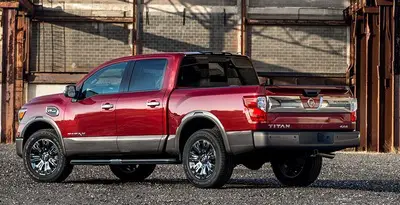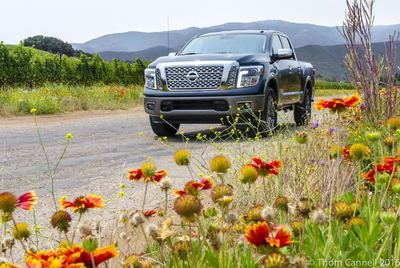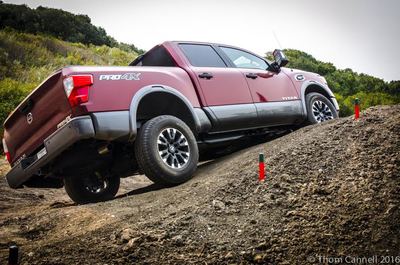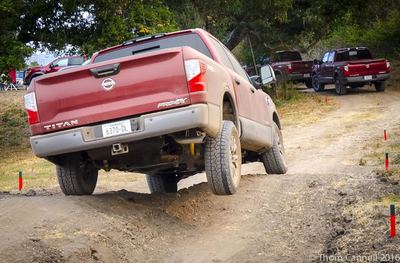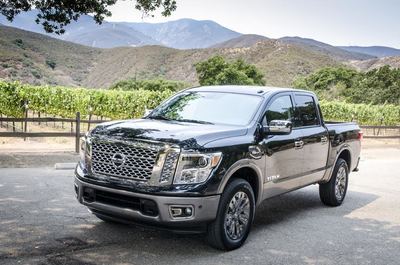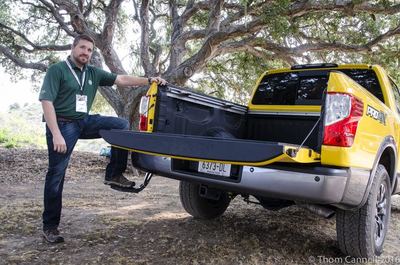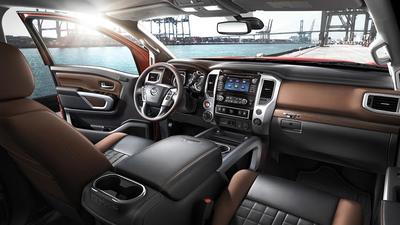2017 Nissan Titan, The Half-ton Pickup You May Have Been Waiting For +VIDEO
By Thom Cannell
Senior Editor
Michigan Bureau
The Auto Channel
Has the world been waiting for Nissan’s new and improved Titan light duty pickup? Hardly. Time marched on and since Titan’s original 2004 debut Chevy, Ford, and Ram all delivered new half-ton trucks. Nissan was long overdue.
Nissan calls 2016 The Year Of The Truck. They’ve launched the longer Titan XD with a Cummins diesel and a Titan XD with a new gas engine. (You can check our stories about the two Titan XDs for details.) So if you’re thinking “We’ve seen that truck,” you’re almost correct, they are the platform for our test of a different truck, the 2017 Titan half-ton.
After hours behind the wheel, checking email and Facebook in rear seats, studying instrument panel layout from the front passenger seat we can tell you Titan is quiet, powerful, and rugged. Off road models are solid and dig deeply into the dirt. Underpinning each 2017 Titan half-ton is a 139.8” wheelbase (versus 151.6” for XD) and power, for now, comes from the same 5.6-liter gasoline engine available in XD.
As buyers now rate features like silence, fuel economy and technology as highly as durability and the never ending horsepower race we questioned if Titan could deliver.
Titan 2017 was designed around an unusual goal, “goodness”. This nebulous concept was described to us by chief product specialist Rich Miller as a promise to be nearly top-of-class in every dimension: fuel economy, ride and handling, steering precision, quietness, comfort, and aerodynamics. Engineers were told to accomplish “goodness” without sacrificing overall capability just to have a single brag, though Titan does have a maximum towing capacity of 9,390 pounds, best in the half-ton segment. That’s a great segue into the new powertrain, which retains its familiar 5.6-liter displacement.
Titan’s engine is Nissan’s new VK56VD 5.6-liter V8 available on Titan XD; a V6 arrives “soon”. Compared to the outgoing V56DE the new motor makes 385 horsepower, a modest improvement over the old 5.6-liter’s 317 horses with marginally increased torque— 390 pound-feet compared to 394 pound-feet. Although this seems inconsequential the engine is actually all-new and retains only machining centers. What separates new from old are improvements like variable valve timing and variable valve lift for both intake and exhaust, exotic technologies used in premium sports cars only a few years ago.
At the Decherd, Tennessee engine plant where this motor is built (with many castings and machining operations performed on site) Nissan has improved build and inspection methods. The new 5.6L has a new head design, revised piston design, new mirror cylinder bore coatings, and a multi-valve switch that segments and controls engine cooling paths. Most important, Nissan added direct injection. These additive technologies contribute to an engine that was promised, and does deliver a flatter torque curve. That’s means increased power anytime you need it. It’s something we could feel every time we accelerated regardless RPM or gear. Overall the new engine has greatly improved drivability.
The powertrain’s “goodness” isn’t simply due to the engine. Original Titans used a 5-speed Jatco transmission. Now a new 7-speed Jatco is coupled to the mill which helps to improve fuel economy, now 15 City/21 Highway /18 Overall EPA miles per gallon. That’s a 28% boost over the outgoing engine.
That same new tranny provides a 4.8:1 low and 7th gear bumps up to 0.7:1 vs. 0.8:1, meaning better launch and a quieter engine at highway cruising speeds. The 7-speed also transforms Titan’s grunt; drop the hammer and the 5,500 pound truck is a beast. Intimately related to the powertrain upgrade and changes in the chassis is that peak tow of 9,390 pounds which Nissan says was recorded in accordance with J2807 standards.
For those of you who tow, Nissan’s offers its one-person trailer light check that operates from the key fob; you only need yourself to check every trailer light. Other tech features include downhill speed control, trailer sway control, a backup camera, and integrated trailer brake control, all are must-haves for any new truck. Assisting towing, as well as ordinary operation, is Nissan’s 360° Around View integrated camera display for vision in tight spaces, front and rear sonar for collision avoidance, cross traffic alert and blind spot warning.
Another “goodness” is comfort on highways, back roads, and off the road. Nissan started with the basic architecture of the first F-Alpha platform, adding strength through thicker frame members and adding gussets to resist twist. Suspension is aimed at commercial use with double wishbone front suspension where 34 mm stabilizer bars and twin tube coil-over dampers are found. At the rear they kept a solid rear axle, changing rates for the springs and adding an 18 mm stabilizer bar. Both the PRO-4X and Platinum Reserve use Bilstein monotube coil-overs. Brakes were all upsized to 13.78” x 1.2” front and 13.58” x 0.8” rear vented discs with electronic brake force distribution and brake assist standard. Additionally there’s improved rack-and-pinion hydraulic steering with a new pump, new assist curve, and a new ratio to improve on-center feel and add linearity to effort. Our conclusion is that it steers very well, very precisely.
During design, structural engineers went after what the industry calls shake, particularly high frequency movement over highway expansion joints. Shake is wearying, annoying, and causes fatigue. Engineers changed the rear cab mounts from simple rubber to large hydraulic mounts to absorb motion. It’s expensive and it works. To enhance quietness they went the conventional route by adding more engine isolation, 3-layer padding which attenuates noise by 3 db, and used laminated glass in the windscreen and side windows while reshaping mirrors. Another objective, kept, was to retune engine noise to keep the V8 rumble but eliminate drone at high rpm. During mountain driving we kept the engine in manual mode at 2,000-4,500 rpm and it stayed sweet—and responsive—mile after mile.
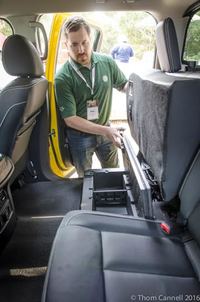 |
On the highway we noticed how quiet the interior was; conversations were easily understood and backseat passengers were included in conversations without leaning and twisting. With twin air outlets flanking the center infotainment system there’s a natural tendency to say it’s derivative because you’ve seen it before. There’s no other place for air vents so Nissan made them bold, flanking the center stack which is horizontally divided and simplicity itself to use. We didn’t try advanced features of the telematic system other than satellite radio.
We know exteriors are controversial and Titan is no exception. Critics say it takes too much from competitors or the nose is overwhelming. We disagree, primarily because of the shoulder cut lines that sweep from headlight over the wheelwell and down into the door, following body lines or sills where the gesture again sweeps up to a hefty rear shoulder line. We find it distinctive and highly athletic. Is the nose over-bold? Ask yourself it a multi-cooler diesel engine or modern EGR-equipped air conditioned V8 will fit behind and you have your design direction.
Because everything counts in automotive design, aerodynamic improvements include using active grille shutters, underfloor covers, a bed seal, both roof and tailgate spoilers, even the hook hole has a cover. Interesting features of the 2017 Titan include damped tailgate, rear bumper step, patented removable Titan box, and multi-bulb LED bed lighting and tailgate lighting. Nissan’s signature Utili-track channels remain with nowhere-else in-bed tie down channels, plus adjustable edge tracks.
For comfort and luxury both SL and Platinum are fitted in premium leathers. The Pro4X uses rugged materials, either cloth or leather, with badged seating. S and SV are equipped with cloth seating. Each model has specific fabrics or leathers and even the stitching is unique to that model. For instance, the Platinum’s leather seats are softer than your best sheepskin gloves and embossed in a distinctive pattern. Like other brands Nissan isn’t shy about placing a TITAN logo wherever there’s room, like at the rear passenger’s center console cup holders or even the console arm rest. Another feature designers are proud of, every truck has its own wheel design. There are five designs, each taking inspiration from hand tools. PHOTO 2017-nissan-titan-interior-black-brown-leather-original
With an eventually complete lineup of two chassis—Titan XD and Titan; Crew Cab, King Cab, and Regular Cab models; eventually three bed lengths (for now only 67” beds are available) Nissan has geared up to meet consumer demands from fleet to luxury.
The model lineup includes base S, SV, Pro4X off roader, SL, and Platinum Reserve. Nissan expects the upscale SL to be its volume with S—regardless cab style—aimed at fleet buyers. Prices start at $34,780 for an S Crew Cab 4x2 (plus $1,195 destination and handling) and top out at $55,400 for the Platinum Reserve Crew Cab 4x4 (plus D&H). Even with this aggressive pricing Nissan has gone a huge step further by adding “America’s Best” warranty of 5 years/100,000 miles bumper-to-bumper versus competitors 3 year/36,000 mile warranties.
Nissan is back, and now a very serious contender.
Find More Unbiased "Tell-Not-Sell" Nissan Vehicle Research Information Than Anywhere!
- Nissan Buyers Guide | Specs, Prices, Expert Reviews Video and Comparisons 2017-1997
- Filter Specs, Prices, Safety and Dimensions To Find Your Perfect New Pick-up Match
- 20 Years of Nissan Reviews
- Nissan Archives; News, Reviews, Specifications, Prices, Video, Images (49,999 Annotations)



